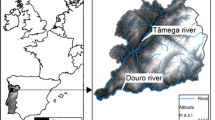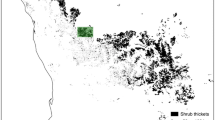Abstract
Californian coastal sage scrub has floristically distinct subassociations with sharp boundaries in the Santa Monica Mountains. This mesoscale biogeographic pattern has been variously attributed to the timing and pattern of fire and to differences in the moisture availability on sites. An examination of the actual fire history of sites reveals that recent fire events are unlikely to have caused the observed patterns. Sites with similar fire histories are not as similar in vegetation as sites with different fire histories but similar aspect. Single short fire intervals do not result in dissimilar communities; fires are unlikely to recur with the same boundaries as these two subassociations. A simulation of shrub response to fire interval and intensity indicates that long-term fire trends are also unlikely to have caused the distinction or the sharp boundaries of the two subassociations. Both subassociations include species with life history characteristics adapted to short and to long fire intervals. The subassociations exist without regard to fire history.
Similar content being viewed by others
References
Axelrod, D., 1978. The origin of coastal sage vegetation, Alta and Baja California. Am. J. Bot. 65: 1117–1131.
Bradbury, D. E., 1978. The evolution and persistence of a local sage chamise community pattern in Southern California. Yearb. Ass. Pacific Coast Geog. 40: 39–56.
Bradfield, G. E., 1981. Component analysis of fire patterns in open eucalypt forest. Aust. J. Ecol. 6: 99–109.
Byrne, R., Michaelson, J. & Soutar, A., 1977. Fossil charcoal as a measure of wildfire frequency in southern California: a preliminary analysis. In: H. A. Mooney & C. E. Conrad (eds.). Symposium on the environmental consequences of fire and fuel management in Mediterranean Ecosystems, pp. 361–367. U.S. For. Serv. Gen. Tech. Rep. WO-3.
Clements, F. E., 1920. Plant indicators. Carnegie Institution, Washington.
Gauch, H. G., 1982. Multivariate analysis in community ecology. Cambridge University Press. Cambridge.
Goodall, D. W., 1978. Sample similarity and species correlation. In: R. H., Whittaker (ed.). Ordination of plant communities, p. 99–149. W. Junk, The Hague.
Gray, J. T., 1982. Community structure and productivity in Ceanothus chaparral and coastal sage scrub of southern California. Ecol. Monogr. 52: 415–435.
Harper, J. L., 1977. Population biology of plants. Academic Press, London.
Harrison, A. T., Small, E. & Mooney, H. A., 1971. Drought relationships and distribution of two mediterranean-climate California plant communities. Ecology 52: 869–875.
Keeley, J. E., 1977. Fire dependent reproductive strategies. In: H. A. Mooney & C. E. Conrad (eds.). Symposium on the environmental consequences of fire and fuel management in Mediterranean ecosystems, pp. 391–396. U.S. For. Serv. Gen. Tech. Rep. WO-3.
Keeley, J. E. & Keeley, S. C., 1984. Postfire recovery of Californian coastal sage scrub. Am. Midl. Nat. 111: 105–117.
Kirkpatrick, J. B. & Hutchinson, C. F., 1977. The community composition of Californian coastal sage scrub. Vegetatio 35: 21–33.
Kirkpatrick, J. B. & Hutchinson, C. F., 1980. The environmental relations of Californian coastal sage scrub and some of its component communities and species. J. Biogeogr. 7: 23–39.
Kruger, F. J., 1983. Plant community diversity and dynamics in relation to fire. In: F. J., Kruger, D. T., Miller & J. V. M., Jarvis (eds.). Mediterranean-type ecosystems. The role of nutrients. p. 447–472. Springer-Verlag, Berlin.
Malanson, G. P., 1983. A model of post-fire succession in Californian coastal sage scrub. Ph.D. thesis, University of California, Los Angeles.
Malanson, G. P., 1984. Linked Leslie matrices for the simulation of succession. Ecol. Modelling 21: 13–20.
Malanson, G. P. & O'Leary, J. F., 1982. Post-fire regeneration strategies of Californian coastal sage shrubs. Oecologia 53: 355–358.
Malanson, G. P. & Westman, W. E., 1984. Post-fire succession in Californian coastal sage scrub: the role of continual basal resprouting. Am. Midl. Nat. In Press.
Pinder, J. E., Weiner, J. G. & Smith, M. H., 1978. The Weibull distribution: a new method of summarizing survivorship data. Ecology 59: 175–179.
Radtke, K. W. H. Arndt, A. M. & Wakimoto, R. H., 1982. Fire history of the Santa Monica Mountains. In: C. E. Conrad & W. C. Oechel (eds.). Dynamics and management of Mediterranean-type ecosystems, pp. 438–443. U.S. for. Serv. Gen. Tech. Rep. PSW-58.
Ruzicka, M., 1958. Anwendung mathematisch-statistischer Methoden in der Geobotanik, (Synthetische Bearbeitung von Aufnahmen). Biologia, Bratislava 13: 647–661.
Specht, R. L., 1981. Responses to fire of heathlands and related shrublands. In: A. M., Gill, R. H., Groves & I. R., Noble (eds.). Fire and the Australian biota. pp. 395–414. Australian Academy of Sciences, Canberra.
Westman, W. E., 1980. Gaussian analysis: identifying environmental factors influencing bell-shaped species distributions. Ecology 61: 170–184.
Westman, W. E., 1981a. Factors influencing the distributions of species of Californian coastal sage scrub. Ecology 62: 439–455.
Westman, W. E., 1981b. Diversity relations and succession in Californian coastal sage scrub. Ecology 62: 170–184.
Westman, W. E., 1982. Coastal sage scrub succession. In: C. E. Conrad & W. C. Oechel (eds.). Dynamics and management of Mediterranean-type ecosystems, pp. 91–99. U.S. For. Serv. Gen. Tech. Rep. PSW-58.
Westman, W. E., 1983. Seric Mediterranean-type shrubland associations of Alta and Baja California and the community/continuum debate. Vegetatio 52: 3–19.
Westman, W. E., O'Leary, J. F. & Malanson, G. P., 1981. The effects of fire intensity, aspect, and substrate of post-fire growth of Californian coastal sage scrub. In: N. S., Margaris & H. A., Mooney (eds.), Components of productivity of Mediterranean regions, pp. 151–179. W. Junk, The Hague.
Author information
Authors and Affiliations
Additional information
Acknowledgements. This research was done as part of a doctoral thesis directed by W. E. Westman at the University of California, Los Angeles. I thank J. F. O'Leary for discussions on this topic, and R. K. Peet for comments on the manuscript. S. E. Coon, S. E. Cunniff, D. Cunningham, L. L. Jones, and A. Martinez helped with field work. L. Loeher helped gather fire history information through K. Ractke of the Los Angeles County Fire Department. W. E. Westman provided previously unpublished data. This research was funded by a UCLA Chancellor's Patent Fund research grant and by National Science Foundation Grant DEB 76-81712 to W. E. Westman. Graphics were produced by G. Maxwell, Cartography Service, Oklahoma State University.
Rights and permissions
About this article
Cite this article
Malanson, G.P. Fire history and patterns of Venturan subassociations of Californian coastal sage scrub. Vegetatio 57, 121–128 (1984). https://doi.org/10.1007/BF00047308
Accepted:
Issue Date:
DOI: https://doi.org/10.1007/BF00047308




